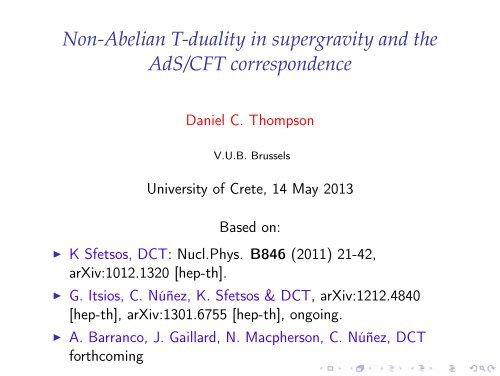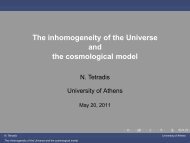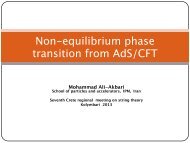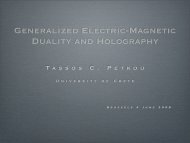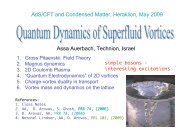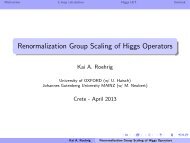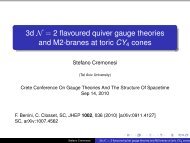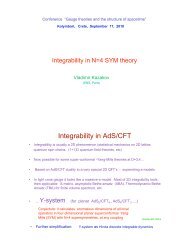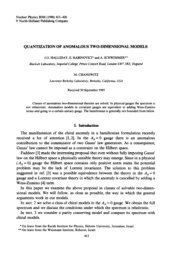Non-Abelian T-duality in supergravity and the AdS/CFT ...
Non-Abelian T-duality in supergravity and the AdS/CFT ...
Non-Abelian T-duality in supergravity and the AdS/CFT ...
You also want an ePaper? Increase the reach of your titles
YUMPU automatically turns print PDFs into web optimized ePapers that Google loves.
<strong>Non</strong>-<strong>Abelian</strong> T-<strong>duality</strong> <strong>in</strong> <strong>supergravity</strong> <strong>and</strong> <strong>the</strong><br />
<strong>AdS</strong>/<strong>CFT</strong> correspondence<br />
Daniel C. Thompson<br />
V.U.B. Brussels<br />
University of Crete, 14 May 2013<br />
Based on:<br />
◮ K Sfetsos, DCT: Nucl.Phys. B846 (2011) 21-42,<br />
arXiv:1012.1320 [hep-th].<br />
◮ G. Itsios, C. Núñez, K. Sfetsos & DCT, arXiv:1212.4840<br />
[hep-th], arXiv:1301.6755 [hep-th], ongo<strong>in</strong>g.<br />
◮ A. Barranco, J. Gaillard, N. Macpherson, C. Núñez, DCT<br />
forthcom<strong>in</strong>g
General sett<strong>in</strong>gs <strong>and</strong> context – Motivation<br />
Generat<strong>in</strong>g solutions <strong>in</strong> <strong>the</strong> context of <strong>AdS</strong>/<strong>CFT</strong><br />
◮ There exist a wide variety of solution generat<strong>in</strong>g techniques <strong>in</strong><br />
<strong>supergravity</strong>.<br />
◮ These techniques provide a powerful tool:<br />
◮<br />
◮<br />
◮<br />
Match<strong>in</strong>g β-deformations <strong>in</strong> gauge <strong>the</strong>ory to <strong>the</strong> TST<br />
transformation <strong>in</strong> gravity.<br />
U-<strong>duality</strong> transformations.<br />
Fermionic T-<strong>duality</strong> & regular T-<strong>duality</strong> to expla<strong>in</strong> dual<br />
superconformal symmetry at strong coupl<strong>in</strong>g.<br />
◮ Some are well understood as exact str<strong>in</strong>g symmetry<br />
(O(d, d; Z) dualities), o<strong>the</strong>rs, like Fermionic T-<strong>duality</strong>, are<br />
probably not - but evidently can be very useful.
Str<strong>in</strong>gs <strong>and</strong> T-dualities <strong>in</strong> curved backgrounds<br />
◮ <strong>Abelian</strong> T-<strong>duality</strong> is well understood <strong>and</strong> explored.<br />
◮ <strong>Non</strong>-<strong>Abelian</strong> T-<strong>duality</strong>? [Fridl<strong>in</strong>g-Jevicki 84, Fradk<strong>in</strong>-Tseytl<strong>in</strong>-85],<br />
[de la Ossa-Quevedo 93, KS-94, Alvarez–Alvarez-Gaume–Lozano 94...]<br />
Not as well understood <strong>and</strong> not likely to be an exact symmetry.<br />
◮ Major advances <strong>in</strong> <strong>the</strong> last two years:<br />
◮<br />
Underst<strong>and</strong><strong>in</strong>g how it acts on RR fluxes.<br />
Generat<strong>in</strong>g solutions <strong>in</strong> type-II supergravities<br />
◮ Reduc<strong>in</strong>g symmetry/supersymmetry (generically) controllably.<br />
◮ New examples <strong>and</strong> features <strong>in</strong> <strong>AdS</strong>/<strong>CFT</strong><br />
◮<br />
◮<br />
It caprures generic features of N = 2 superconformal field<br />
<strong>the</strong>ories correspond<strong>in</strong>g to quiver (moose-type) diagrams.<br />
New (non-s<strong>in</strong>gular) flows with N = 1 supersymmetry.
Outl<strong>in</strong>e<br />
◮ Construct<strong>in</strong>g <strong>the</strong> backgrounds: General strategy<br />
◮<br />
◮<br />
◮<br />
The tranformation of <strong>the</strong> NS fields.<br />
The <strong>in</strong>duced Lorentz tranformation.<br />
The tranformation of <strong>the</strong> RR fluxes.<br />
◮ Type-II backgrounds with SO(4) isometry:<br />
◮<br />
◮<br />
◮<br />
In Pr<strong>in</strong>cipal Chiral Models (<strong>in</strong>termediate step).<br />
The general transformation rules.<br />
Supersymmetry.<br />
◮ <strong>Non</strong>-<strong>Abelian</strong> T-<strong>duality</strong> <strong>and</strong> <strong>AdS</strong>/<strong>CFT</strong>: The road map.<br />
◮<br />
◮<br />
N = 2 backgrounds, from D3-brane near horizon, M-<strong>the</strong>ory<br />
lift <strong>and</strong> <strong>in</strong>terpretation.<br />
N = 1 backgrounds from conifolds, Conformal <strong>and</strong><br />
non-conformal cases, fate of charges (central <strong>and</strong> brane).<br />
◮ Conclud<strong>in</strong>g remarks.
Construct<strong>in</strong>g <strong>the</strong> backgrounds: General strategy<br />
Consider a type-II background with an isometry group G.<br />
The tranformation of NS fields<br />
Write <strong>the</strong> 2-dim σ model action for <strong>the</strong> NS fields<br />
∫<br />
S(X ) = d 2 σ(G µν + B µν )∂ + X µ ∂ − X ν , also a Φ .<br />
◮ Gauge H ⊂ G: gauge fields A ± ∈ L(H) <strong>and</strong> ∂ → ∇,<br />
∫<br />
S T−dual (X , v, A ± ) = S g (X , A ± ) − i<br />
d 2 σ Tr(vF +− ) , S g (X , 0) = S(X ) .<br />
} {{ }<br />
Lagr.mult.<br />
Invariant under <strong>the</strong> transformation of <strong>the</strong> X µ ’s <strong>and</strong><br />
A ± → Λ −1 (A ± − ∂ ± )Λ , v → Λ −1 vΛ .<br />
◮ Gauge fix dim(H) parameters <strong>in</strong> X µ <strong>and</strong> <strong>in</strong> <strong>the</strong> v’s.
The gauge fields A ± appear quadratically <strong>and</strong> non-dynamically.<br />
Integrat<strong>in</strong>g <strong>the</strong>m out (<strong>in</strong> a [Buscher 87]–like procedure) gives <strong>the</strong><br />
T-dual σ-model.<br />
◮ Some of <strong>the</strong> Langrange multipliers become σ-model variables.<br />
◮ The dilaton transformation is a 1-loop quantum effect.<br />
◮ This procedure is a canonical transformation <strong>in</strong> phase space.
Induced Lorentz transformation<br />
Us<strong>in</strong>g <strong>the</strong> frame of <strong>the</strong> orig<strong>in</strong>al background construct<br />
e a ± = ɛ a µ∂ ± X µ ,<br />
◮ Left <strong>and</strong> right world-sheet derivatives transform differently <strong>and</strong><br />
give rise to different T-dual frames ẽ a µ±.<br />
◮ A Lorentz transformation relates <strong>the</strong> frames <strong>in</strong> <strong>the</strong> vector rep<br />
ẽ a µ+ = Λ a bẽ a µ− .<br />
◮ Then compute <strong>the</strong> Lorentz transform <strong>in</strong> <strong>the</strong> sp<strong>in</strong>or rep us<strong>in</strong>g<br />
Ω −1 Γ a Ω = Λ a bΓ b ,<br />
which preserves <strong>the</strong> Clifford algebra {Γ a , Γ b } = 2η ab .
Transformation of Ramond fluxes<br />
Use <strong>the</strong> democratic formulation of type-II [Bergshoeff, Kallosh, Ort<strong>in</strong>,<br />
Roest, Van Proeyen 01]; All F p ’s p = 0, 1, . . . , 9 appear.<br />
For M<strong>in</strong>kowski signature<br />
Reduction conditions : F p = (−1) [ p 2 ] ⋆ F 10−p ,<br />
reduce to <strong>the</strong> right degrees of freedom.<br />
◮ We comb<strong>in</strong>e <strong>the</strong> forms RR-forms <strong>in</strong>to a bi-sp<strong>in</strong>or as<br />
IIB : P = eΦ 2<br />
4<br />
∑<br />
n=0<br />
/F 2n+1<br />
(2n + 1)! , IIA : ˆP = êΦ 2<br />
5<br />
∑<br />
n=0<br />
/ˆF 2n<br />
(2n)! ,<br />
where /F p = Γ µ1 ...m p<br />
F µ 1µ 2 ...m p<br />
p .<br />
◮ The above fluxes transform accord<strong>in</strong>g to<br />
ˆP = PΩ −1 ,<br />
us<strong>in</strong>g <strong>the</strong> pure sp<strong>in</strong>or superstr<strong>in</strong>g formalism of [Berkovits 00].
General comments on <strong>the</strong> T-dual background<br />
<strong>Abelian</strong> T-<strong>duality</strong>:<br />
◮ For d successive ones<br />
Λ = diag( −1<br />
}{{} d , 1 10−d ) .<br />
} {{ }<br />
Duality Extras<br />
The sp<strong>in</strong>orial representation is [Hassan 99]<br />
d<br />
Ω = ∏<br />
i=1<br />
(Γ i Γ 11 ) ,<br />
where Γ 11 = Γ 0 Γ 1 · · · Γ 9 , obey<strong>in</strong>g Γ 2 11 = 1.<br />
◮ A s<strong>in</strong>gle <strong>Abelian</strong> factor changes <strong>the</strong> chirality form type-IIA to<br />
type IIB <strong>and</strong> vice versa.
<strong>Non</strong>-<strong>Abelian</strong> T-<strong>duality</strong>:<br />
◮ dim(G ) =odd: Ω starts with Γ 11 followed by a l<strong>in</strong>ear<br />
comb<strong>in</strong>ation of products of an odd number of Γ-matrices.<br />
◮ dim(G ) =even: Then Γ 11 is omitted <strong>and</strong> <strong>the</strong> l<strong>in</strong>ear<br />
comb<strong>in</strong>ation has products of an even number of Γ-matrices.<br />
◮ Hence, chirality might change or stay <strong>the</strong> same.<br />
◮ Massive IIA solutions, when dim(G ) equals <strong>the</strong> rank of a form.<br />
◮ Equations of motion should be automatically satisfied.<br />
◮ Supersymmetry:<br />
◮<br />
◮<br />
This may be reduced to a fraction of <strong>the</strong> orig<strong>in</strong>al.<br />
Later we develop a criterion based on <strong>the</strong> action of <strong>the</strong><br />
Lie-Lorrentz or Kosmann derivative on <strong>the</strong> Kill<strong>in</strong>g sp<strong>in</strong>ors of<br />
<strong>the</strong> orig<strong>in</strong>al background.
Type-II backgrounds with SO(4) isometry<br />
Orig<strong>in</strong>al background with SO(4) isometry<br />
We consider (for concreteness) type-IIB backgrounds:<br />
◮ The NS fields are<br />
ds 2 = ds 2 (M 7 ) + e 2A ds 2 (S 3 ) , B , Φ .<br />
◮ The factor A, <strong>the</strong> 2-form B <strong>and</strong> Φ may depend on M 7 .<br />
◮ The RR fluxes respect<strong>in</strong>g <strong>the</strong> symmetry of <strong>the</strong> round S 3 are<br />
F 5 = G 2 ∧ Vol(S 3 ) − e −3A ⋆ 7 G 2 ,<br />
F 3 = G 3 − mVol(S 3 ) ,<br />
F 1 = G 1 .<br />
The G i ’s are ly<strong>in</strong>g entirely on M 7 .<br />
◮ The T-<strong>duality</strong> will be performed w.r.t. <strong>the</strong> SU(2) L subgroup of<br />
SO(4) ∼ SU(2) L × SU(2) R .
<strong>Non</strong>-<strong>Abelian</strong> T-<strong>duality</strong> <strong>in</strong> Pr<strong>in</strong>cipal Chiral Models (PCM)<br />
◮ The 2-dim σ-model action for a PCM is<br />
∫<br />
S(g) = − d 2 σ Tr(g −1 ∂ − gg −1 ∂ + g) , g ∈ G .<br />
◮ It has an G L × G R global symmetry.<br />
◮ Gauge <strong>the</strong> symmetry G L by <strong>in</strong>troduc<strong>in</strong>g gauge fields A ± .<br />
◮ The correspond<strong>in</strong>g action is<br />
∫<br />
S nonab = −<br />
d 2 σ Tr(g −1 D − gg −1 D + g) +<br />
Lagr. Multip.<br />
{ }} {<br />
iTr(vF +− ) ,<br />
with D ± g = ∂ ± g − A ± g <strong>and</strong> F +− <strong>the</strong> field strength.<br />
◮ Invariance under G L (local) ×G R (global).
◮ Gauge fix g = 1<strong>and</strong> <strong>in</strong>tegrate out <strong>the</strong> A ± ’s<br />
where<br />
∫<br />
S T−dual (v) = d 2 σ ∂ + v a (M −1 ) ab ∂ − v b ,<br />
M ab = δ ab + f ab , f ab ≡ f ab c v c .<br />
Contribution to <strong>the</strong> Dilaton: Φ = − 1 2<br />
ln det(M).<br />
◮ Orig<strong>in</strong>al isometry G L × G R is broken to G R .<br />
◮ Introduce coord<strong>in</strong>ates X µ ∈ g <strong>and</strong> <strong>the</strong> left-<strong>in</strong>variant forms L a .<br />
◮ Then, <strong>the</strong> relation of world-sheet derivatives is<br />
∂ + v a = M ba L b µ∂ + X µ , ∂ − v a = −M ab L b µ∂ − X µ .<br />
◮ These def<strong>in</strong>e two frames related by <strong>the</strong> Lorentz transformation<br />
Λ ab = −(MM −1T ) ab .<br />
Then<br />
( ) dim(G )<br />
1<br />
Ω = exp<br />
2 f abΓ ab ∏ (Γ 11 Γ i ) .<br />
i=1
T-dual background w.r.t. SU(2); NS-sector<br />
◮ We specialize to <strong>the</strong> case of a PCM for SU(2) <strong>and</strong><br />
◮ use spherical coord<strong>in</strong>ates <strong>and</strong><br />
◮ take <strong>in</strong>to account e 2A .<br />
◮ The NS-sector fields are given by<br />
dŝ 2 = ds 2 (M 7 ) + e −2A dr 2 +<br />
ˆB = B +<br />
r 3<br />
r 2 + e 4A Vol(S2 ) ,<br />
e −2 ˆΦ = e −2Φ e 2A (r 2 + e 4A ) ,<br />
r 2 e 2A<br />
r 2 + e 4A ds2 (S 2 ) ,<br />
◮ The round S 2 sphere appears; Manifest SU(2) symmetry.
T-dual background w.r.t. SU(2); RR-sector<br />
◮ The Lorentz transformation matrix Ω act<strong>in</strong>g on <strong>the</strong> sp<strong>in</strong>ors is<br />
Ω = Γ 11<br />
e 2A Γ 789 + v · Γ<br />
√<br />
r 2 + e 4A =⇒ Ω −1 = Γ 11<br />
e 2A Γ 789 − v · Γ<br />
√<br />
r 2 + e 4A .<br />
◮ The isometry group is 3-dim <strong>and</strong> has “legs” along F 3 .<br />
Hence we expect a massive IIA solution.<br />
◮ Indeed, <strong>the</strong> massive IIA fluxes are<br />
ˆF 0 = m ,<br />
ˆF 2 = mr 3<br />
r 2 + e 4A Vol(S2 ) + rdr ∧ G 1 − G 2 ,<br />
ˆF 4 =<br />
r 2 e 4A<br />
r 2 + e 4A G 1 ∧ dr ∧ Vol(S 2 r<br />
) −<br />
3<br />
r 2 + e 4A G 2 ∧ Vol(S 2 )<br />
+ rdr ∧ G 3 + e 3A ⋆ 7 G 3 .
Supersymmetry<br />
◮ Is any/how much Supersymmetry preserved? what conditions?<br />
Preserved susy when Lie-Lorentz or Kosmann derivative<br />
vanishes<br />
L ξ ɛ = ξ µ D µ ɛ + 1 4 D µξ ν Γ µν ɛ ,<br />
◮ Is <strong>the</strong>re a mapp<strong>in</strong>g of <strong>the</strong> Kill<strong>in</strong>g sp<strong>in</strong>or eqs/sp<strong>in</strong>ors?<br />
ˆɛ 1 = Ωɛ 1 , ˆɛ 2 = ɛ 2<br />
◮ The fraction of supersymmetry preserved is determ<strong>in</strong>ed by <strong>the</strong><br />
<strong>in</strong>dependent extra conditions needed to make <strong>the</strong> Kosmann<br />
derivative vanish.
<strong>Non</strong>-<strong>Abelian</strong> T-<strong>duality</strong> <strong>and</strong> <strong>AdS</strong>/<strong>CFT</strong>: The Road Map<br />
<br />
<br />
<br />
<br />
<br />
<br />
<br />
<br />
<br />
<br />
<br />
!"<br />
#$#% <br />
<br />
<br />
<br />
<br />
&!'
N = 2 backgrounds<br />
D3 near horizon<br />
◮ We write <strong>the</strong> S 5 of <strong>the</strong> orig<strong>in</strong>al type-IIB background as<br />
ds 2 (S 5 ) = 4(dθ 2 + s<strong>in</strong> 2 θ dφ 2 ) + cos 2 θ ds 2 (S 3 ) .<br />
◮ The NS-part of <strong>the</strong> T-dual background has<br />
ds 2 = ds 2 (<strong>AdS</strong> 5 ) + 4(dθ 2 + s<strong>in</strong> 2 θdφ 2 ) + dr 2<br />
cos 2 θ + r 2 cos 2 θ<br />
cos 4 θ + r 2 dΩ2 2 ,<br />
a dilaton <strong>and</strong> an NS 2-form, as well as<br />
F 2 = −8 cos 3 θ s<strong>in</strong> θ dθ ∧ dφ ,<br />
F 4 = −8 r 3 cos 3 θ s<strong>in</strong> θ<br />
cos 4 θ + r 2 dθ ∧ dφ ∧ Vol(S 2 ) ,<br />
◮ A type-IIA solution with SO(4, 2) × SU(2) × U(1) symmetry.<br />
◮ Solution is s<strong>in</strong>gular at θ = π/2 <strong>and</strong> 1/2 supersymmetric.
M-<strong>the</strong>ory lift <strong>and</strong> gauge <strong>the</strong>ory <strong>in</strong>terpretation<br />
N = 2 superconf. quiver <strong>the</strong>ories us<strong>in</strong>g D4,D6 <strong>and</strong> NS5-branes.<br />
k 1<br />
k 2<br />
k N<br />
d 1 d 2 d N<br />
◮ Notation:<br />
Circular: SU(k n ) gauge group. Square: SU(d n ) global (d n<br />
fundamentals), Horizontal l<strong>in</strong>es: bi-fundamental (k n−1 , ¯k n ).<br />
◮ They admit 11-dim dual geometries conta<strong>in</strong><strong>in</strong>g <strong>AdS</strong> 5 factors<br />
<strong>and</strong> possess<strong>in</strong>g SU(2) × U(1) isometry [Gaiotto-Maldacena 09],<br />
◮ The details of <strong>the</strong> solution are fed up us<strong>in</strong>g solutions of<br />
(∂ 2 x + ∂ 2 y )Ψ + ∂ 2 ze Ψ = 0 ,<br />
<strong>the</strong> cont<strong>in</strong>ual Toda eq. [Boyer-F<strong>in</strong>ley 82, Saveliev 89].
The relation to <strong>the</strong> quiver <strong>the</strong>ories is very clear <strong>in</strong> <strong>the</strong> subclass<br />
hav<strong>in</strong>g an additional U(1) symmetry:<br />
◮ Corresponds, via dim reduction, to a type-IIA solution.<br />
◮ There is a mapp<strong>in</strong>g of <strong>the</strong> cont<strong>in</strong>ual Toda to <strong>the</strong> Laplace eq.<br />
◮ Electrostatic problem: F<strong>in</strong>d <strong>the</strong> potential V (ρ, η) of a<br />
semi-<strong>in</strong>f<strong>in</strong>ite charged l<strong>in</strong>e with density λ(η).<br />
Charge l<strong>in</strong>e<br />
Conduct<strong>in</strong>g plane<br />
Image l<strong>in</strong>e<br />
Figure: A charged l<strong>in</strong>e perpendicular to an <strong>in</strong>f<strong>in</strong>ite conduct<strong>in</strong>g plane.<br />
◮ λ(η) is composed of l<strong>in</strong>ear segments with <strong>in</strong>teger slopes.<br />
◮ The rank of <strong>the</strong> gauge group k n = λ(n), with n = 1, 2, . . . .<br />
Changes <strong>in</strong> slope correspond to extra fundamentals d n .
The non-<strong>Abelian</strong> T-dual captures generic features:<br />
◮ Our solution can be cast <strong>in</strong>to that form with<br />
( η 2 )<br />
λ(η) = η , V (ρ, η) = η ln ρ + η<br />
} {{ } 3 − ρ2 ,<br />
2<br />
source } {{ }<br />
1st harmonic<br />
◮ Describes <strong>the</strong> general geometry near <strong>the</strong> orig<strong>in</strong> (small η).<br />
◮ Change of <strong>the</strong> gauge group:<br />
The orig<strong>in</strong>al SU(N) has changed to ∏ SU(i).<br />
i=2
N = 1 Backgrounds<br />
Remarks/Quastions:<br />
◮ Can <strong>the</strong> same amount of supersymmetry be preserved?<br />
◮ Are <strong>the</strong>re non-s<strong>in</strong>gular (non)-<strong>Abelian</strong> T-duals?<br />
The answer is yes!<br />
◮ D3-brane on a conifold s<strong>in</strong>gularity [Klebanov-Witten 98].<br />
N=1 S<strong>CFT</strong> with SU(N) × SU(N) gauge group.<br />
◮<br />
The gravity dual is <strong>AdS</strong> 5 × T 1,1 , with<br />
T 1,1 =<br />
SU(2) × SU(2)<br />
U(1)<br />
.<br />
The symmetry group is SO(4, 2) × SU(2) × SU(2) × U(1).
Up lift of <strong>the</strong> non-<strong>Abelian</strong> dual of <strong>the</strong> KW<br />
The non-<strong>Abelian</strong> T-dual is a type-IIA with g, B, Φ, F 2 <strong>and</strong> F 4 .<br />
Uplift to 11-dims:<br />
◮ The metric<br />
( ) [<br />
ds 2 = ∆ 1/3 ds<strong>AdS</strong> 2 5<br />
+ λ 2 1 (σ2 1 + σ2 2 ) + ∆ −2/3 (x1 2 + λ2 λ 2 1 )dx2 1<br />
(<br />
+(x2 2 + λ4 1 )dx2 2 + 2x 1x 2 dx 1 dx 2 + λ 2 λ 2 1 x2 1 σ2ˆ3 + dx ♯ + σ ) ]<br />
3 2<br />
27<br />
,<br />
where ∆ = λ 2 2 x 2 1 + λ2 (x 2 2 + λ4 2 ) <strong>and</strong> λ = 1 3 , λ 1 = λ 2 = 1 √<br />
6<br />
.<br />
◮ There is also an F 4 flux.<br />
◮ Preserves N = 1 superconformal. In <strong>the</strong> class of<br />
[Gauntlett-Martelli-Sparks-Waldram 04] <strong>and</strong> [Bah-Beem-Bobev-Wecht<br />
12].
Susy preserved <strong>and</strong> non s<strong>in</strong>gular<br />
◮ The Kosman derivative of <strong>the</strong> orig<strong>in</strong>al T 1,1 Kill<strong>in</strong>g sp<strong>in</strong>ors<br />
vanishes<br />
L k1 ɛ ∼ L k2 ɛ ∝ (Γ 12 + Γ 34 )ɛ ∼ 0 , L k3 ɛ = 0 ,<br />
◮ S<strong>in</strong>gularities associated to fixed po<strong>in</strong>ts of <strong>the</strong> isometry (c.f.<br />
polar U(1) <strong>duality</strong> <strong>in</strong> R 2 ), po<strong>in</strong>ts where <strong>the</strong> norms of <strong>the</strong><br />
kill<strong>in</strong>g vectors vanish. But<br />
|k i | 2 > 0<br />
◮ Subtlety: Removable bolt s<strong>in</strong>gularity dictates a halv<strong>in</strong>g of <strong>the</strong><br />
range of angular coord<strong>in</strong>ate ψ: possible sign of an orientifold?<br />
◮ Preserves N = 1 superconformal.
Can we brake conformal <strong>in</strong>variance but reta<strong>in</strong> supersymmetry?<br />
◮ Include M fractional D3-branes by turn<strong>in</strong>g H 3 , F 3 <strong>and</strong> a Φ<br />
[Klebanov-Nekrasov 99, Klebanov-Tseytl<strong>in</strong> 00, Klebanov-Strassler 00].<br />
◮ Theory becomes non-conformal N = 1 with<br />
SU(N + M) × SU(N) gauge group.<br />
◮ An RG flow which is non-s<strong>in</strong>gular at all scales.<br />
◮ For simplicity concentrate on <strong>the</strong> UV regime <strong>in</strong> which<br />
where<br />
ds 2 = e −5q ds5 2 + 1 +3q<br />
2 e2f (dθ<br />
6 i 2 + s<strong>in</strong> 2 θ i dφi 2)<br />
i=1<br />
+ 1 9 e3q−8f (dψ + cos θ 1 dφ 1 + cos θ 2 dφ 2 ) 2 ,<br />
∑<br />
ds 2 5 = du2 + e 2A η µν dx µ dx ν .<br />
Also, <strong>the</strong>re is a self-dual F 5 , Φ = const. <strong>and</strong><br />
B = PT (u)[Vol(S 2 1 ) − Vol(S 2 2 )] , F 3 ∼ P[Vol(S 2 1 ) − Vol(S 2 2 )] ∧ (dψ + · · · ) .<br />
The constant P ∼ M/N.
Important characteristics:<br />
◮ f , q, T <strong>and</strong> A satisfy a non-l<strong>in</strong>ear system of eqs.; Solvable.<br />
◮ The R-symmetry corresponds to shifts of ψ.<br />
◮ The Kill<strong>in</strong>g sp<strong>in</strong>ors do not dependent on ψ.<br />
What happens when T-<strong>duality</strong> acts?<br />
◮ <strong>Abelian</strong> T-<strong>duality</strong>: Will be a solution of type-IIA.<br />
◮ w.r.t. ψ will break supersymmetry <strong>and</strong><br />
◮ w.r.t. to any φ i will lead to a s<strong>in</strong>gular background.<br />
◮ <strong>Non</strong>-<strong>Abelian</strong> T-<strong>duality</strong>: Will be a solution of massive type-IIA.<br />
◮<br />
Will have F 0 , F 2 <strong>and</strong> F 4 turned on. In particular,<br />
F 0 ∼ M ,<br />
<strong>the</strong> Romans’ mass is quantised.<br />
◮ The global symmetry is SU(2) × U(1) ψ .<br />
◮ <strong>Non</strong>-s<strong>in</strong>gular with unbroken Supersymmetry.
Fate of <strong>the</strong> central charge<br />
◮ The central charge: For <strong>the</strong> metric<br />
it is of <strong>the</strong> form<br />
ds 2 = α(u)dx 2 1,3 + du2 + g ij (x, u)dx i dx j ,<br />
c ∼ H7/2<br />
∫<br />
α 3/2 (H ′ ) 3 , H = α3 V<strong>in</strong>t 2 , V <strong>in</strong>t =<br />
<strong>Non</strong>-<strong>in</strong>creas<strong>in</strong>g towards <strong>the</strong> IR [Girardello et. al. 98].<br />
d 5 xe −2Φ√ det g .<br />
◮ Invariant of T-<strong>duality</strong> up to a s<strong>in</strong>gle RG scale background<br />
<strong>in</strong>dependent coefficient.<br />
◮ Invariance of <strong>the</strong> ratio<br />
c IR<br />
= 27<br />
c UV 32 ,<br />
for <strong>the</strong> RG flow from <strong>AdS</strong> 5 × S 5 /Z 2 to <strong>AdS</strong> 5 × T 1,1 as well as<br />
for <strong>the</strong>ir T-duals.
Fate of <strong>the</strong> brane charges<br />
There are three type of charges (for a review, see [Marolf 00]).<br />
Gauge <strong>in</strong>variant localized conserved quantized<br />
Brane sources Yes Yes No No<br />
Maxwell Yes No Yes No<br />
Page No Yes Yes Yes<br />
Maxwell:<br />
Before :<br />
After :<br />
Page:<br />
Before :<br />
After :<br />
∫<br />
∫<br />
Q D3 ∼ F 5 ∼ N ln r ,<br />
θ i ,φ i ,ψ<br />
∫<br />
Q D5 ∼ F 3 = M ,<br />
θ 1 ,φ 1 ,ψ<br />
Q D6 ∼ F 2 ∼ N ln r ,<br />
θ 1 ,φ 1<br />
Q D8 = M .<br />
∫<br />
∫<br />
Q D3 ∼ (F 5 − B ∧ F 3 ) = N 0 , Q D5 ∼ (F 3 − B ∧ F 1 ) = M<br />
θ i ,φ i ,ψ<br />
∫<br />
θ 1 ,φ 1 ,ψ<br />
Q D6 ∼ (F 2 − F 0 B) = N 0 ,<br />
θ 1 ,φ 1<br />
Q D8 = M .<br />
<strong>Non</strong>-s<strong>in</strong>gular number of “mobile” D3 N 0 = 0
Seiberg <strong>duality</strong><br />
To compute <strong>the</strong> change <strong>in</strong> <strong>the</strong> gauge group along <strong>the</strong> RG flow one<br />
computes <strong>the</strong> effective brane charges. Follow<strong>in</strong>g a procedure as <strong>in</strong><br />
[Ben<strong>in</strong>i-Canoura-Cremonesi-Nunez-Ramallo 07]:<br />
◮ This can be done by realiz<strong>in</strong>g that a shift <strong>in</strong> <strong>the</strong> NS charge as<br />
b 0 → b 0 + n , b 0 = 1<br />
4π 2 ∫<br />
leaves <strong>the</strong> str<strong>in</strong>g <strong>the</strong>ory <strong>in</strong>variant.<br />
Σ 2<br />
B ,<br />
◮ Can be compensated by a shift <strong>in</strong> <strong>the</strong> holographic coord<strong>in</strong>ate<br />
which changes <strong>the</strong> Maxwell charges.<br />
◮ At a fixed energy scale perform a large gauge transformation<br />
by chang<strong>in</strong>g B → B + ∆B. This affects <strong>the</strong> Page charges.<br />
◮ Both procedures give <strong>the</strong> same result. It turns out that a<br />
change of ∆Q D3 = M units <strong>in</strong> <strong>the</strong> KT case, <strong>in</strong>duces a change<br />
of ∆Q D6 = 2M after <strong>the</strong> transformation.
O<strong>the</strong>r probes<br />
We can consider fur<strong>the</strong>r observables <strong>and</strong> also probe IR physics<br />
(us<strong>in</strong>g dual of full KS or KS+bb or Wrapped D5)<br />
◮ Doma<strong>in</strong> walls <strong>in</strong> IR : match<strong>in</strong>g of effective tension (wrapped<br />
D5 → unwrappedD2)<br />
◮ Wilson loop/q ¯q potential preserved<br />
◮ ’t Hooftl<strong>in</strong>e/monopole potential not preserved but still<br />
becom<strong>in</strong>g effective tension goes to zero <strong>in</strong> IR (wrapped D3 →<br />
wrapped D4 on Σ 2 )<br />
◮ Gauge coupl<strong>in</strong>g (<strong>in</strong>stanton action of euclidean D1 brane on Σ 2<br />
→ euclidean D3 brane on Σ 3 ) 1/g 2 → ρ <strong>in</strong> IR
G-structures<br />
◮ KW, KT etc. N = 1 backgrounds: Ω 3 <strong>and</strong> J 2 or SU(3)<br />
structure.<br />
Φ 1 = Ω 3 , Φ 2 = e −iJ ,<br />
(d + H)Φ 1 = 0 , (d + H)Φ 2 = F RR<br />
◮ These pure sp<strong>in</strong>ors transform like RR fluxes:<br />
e φ Φ i = e ˆφ ˆΦ · Ω −1<br />
◮ Shows <strong>the</strong> duals produced above are SU(2) structure <strong>and</strong><br />
N = 1 SUSY<br />
ˆΦ 1 = e −v∧w ∧ ω 2 ,<br />
ˆΦ 2 = e −ij ∧ (v + iw)
Flavours<br />
◮ Add D7 flavour branes to KW (susy callibration conditions<br />
[Areán et al. , Martucci <strong>and</strong> Smyth])<br />
◮ Beyond probe/quenched limit N f ∼ N c by smear<strong>in</strong>g encoded<br />
by a smear<strong>in</strong>g form<br />
Ξ 2 = −N f<br />
(<br />
s<strong>in</strong> θdθ ∧ dφ + s<strong>in</strong> ˜θd ˜θ ∧ d ˜φ )<br />
◮ Modified Bianchi identities dF 1 = Ξ 2 <strong>and</strong> accommodate back<br />
reaction with this ansatz<br />
ds 2 = e Φ 2<br />
√ dx1,3 2 + e Φ √ )<br />
2 h<br />
(dr 2 + λ 2 1 e2g (s<strong>in</strong> 2 θd ϕ 2 + dθ 2 ) + λ 2 2 e2g (σ1 2 + σ2 2 ) + λ2 e 2f (σ 3 + cos θd ϕ) 2 ,<br />
h<br />
F 1 = N f<br />
4π (σ 3 + cos θd ϕ) , F 5 = (1 + ⋆)dt ∧ dx 1 ∧ dx 2 ∧ dx 3 ∧ Kdr .<br />
◮ 1 st order BPS equations which can be solved!<br />
(1)
Flavours: The T-dual<br />
◮ Can T-dualise as before, complicated geometry but SU(2)<br />
structure <strong>and</strong> SUSY<br />
◮ Source D7s → source D6 <strong>and</strong> D8.<br />
◮ T-dual smear<strong>in</strong>g forms transform similar to RR fluxes:<br />
e Φ Ξ = e ˆΦ e B∧ ˆΞ<br />
◮ T-dual Bianchi Identities<br />
(d − Ĥ) ∧ ˆF = e ˆB∧ ˆΞ<br />
◮ Can now add flavours to all <strong>the</strong> <strong>in</strong>terest<strong>in</strong>g IIA backgrounds<br />
described.<br />
◮ Side remark - change <strong>in</strong> B redistributes D4, D6 charges
Y p,q <strong>and</strong> its T-dual<br />
◮ Y p,q are an <strong>in</strong>f<strong>in</strong>ite class of Sasaki-E<strong>in</strong>ste<strong>in</strong> manifolds [Gauntlett<br />
et al.]<br />
◮ <strong>AdS</strong> 5 × Y p,q are an <strong>in</strong>f<strong>in</strong>ite class of <strong>AdS</strong>-<strong>CFT</strong> dual pairs <strong>in</strong><br />
type IIB [Martelli <strong>and</strong> Sparks, Benvenuti et al., Franco et al.]<br />
◮ Isometry group SU(2) × U(1) × U(1) so can dualise w.r.t.<br />
SU(2)<br />
◮ Kosmann vanishes <strong>and</strong> Kill<strong>in</strong>g norm non-zero ⇒ susy <strong>and</strong><br />
smooth<br />
◮ Result: a new <strong>in</strong>f<strong>in</strong>ite class of solutions <strong>in</strong> type IIA with<br />
dynamic SU(2) structure <strong>and</strong> M-<strong>the</strong>ory lifts!<br />
◮ Metric reta<strong>in</strong>s many of <strong>the</strong> features of <strong>the</strong> dual KW <strong>and</strong><br />
supported by B, F 2, F 4
Conclud<strong>in</strong>g remarks<br />
1. <strong>Non</strong>-<strong>Abelian</strong> T-<strong>duality</strong> extended to type II <strong>supergravity</strong><br />
2. <strong>AdS</strong> 5 × T 11 <strong>and</strong> its deformations give new smooth solutions<br />
with N = 1 <strong>in</strong> (massive) IIA & M-<strong>the</strong>ory<br />
3. Probes <strong>in</strong>dicate <strong>duality</strong> cascade <strong>and</strong> conf<strong>in</strong><strong>in</strong>g<br />
4. Classified solutions <strong>in</strong> terms of SU(2) structure<br />
5. Showed how to add flavour branes beyond <strong>the</strong> quenched<br />
approximation<br />
6. A new <strong>in</strong>f<strong>in</strong>ite class of M-<strong>the</strong>ory solutions from dualis<strong>in</strong>g Y p,q<br />
◮ Opens Qs: better h<strong>and</strong>le on gauge <strong>the</strong>ory; <strong>in</strong>tegrability; global<br />
issues; generalised geometry


